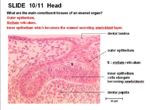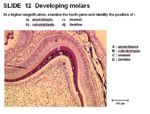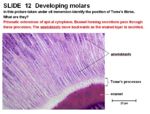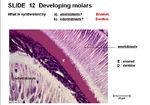Diferencia entre revisiones de «Organo de Esmalte»
m (→Cemento) |
m |
||
| (No se muestran 4 ediciones intermedias de otro usuario) | |||
| Línea 26: | Línea 26: | ||
The densest bone called the '''cribiform plate''' lines the alveolus. This appears white on radiographs and is referred to as the '''[[Organo de Esmalte#Lamina Dura|lamina dura]]'''. | The densest bone called the '''cribiform plate''' lines the alveolus. This appears white on radiographs and is referred to as the '''[[Organo de Esmalte#Lamina Dura|lamina dura]]'''. | ||
| − | + | ||
| − | |||
===Lamina Dura=== | ===Lamina Dura=== | ||
| − | + | The '''lamina dura''' lines the [[Organo de Esmalte#Hueso Alveolar|hueso alveolar]]. If uninterrupted, it indicates good dental health. | |
| − | + | ||
| + | The '''lamina dura''' is seen as a white line radiographically. | ||
===Esmalte=== | ===Esmalte=== | ||
| − | + | Enamel has an '''ectodermal''' origin. It is synthesised by [[Organo de Esmalte#Ameloblastos|ameloblastos]]. It is very hard, densly calcified and '''acellular''', therefore cannot regenerate. | |
| − | + | Complicated enamel folding occurs in teeth where the '''[[Organo de Esmalte#Corona|coronas]]''' are high. Enamel forming secretions pass through processes of apical cytoplasmic extension called '''Thomes' Fibres'''. | |
===Dentina=== | ===Dentina=== | ||
| − | ''' | + | '''Dentine''' is a calcified, collagen rich matrix. It is synthesised by '''[[Organo de Esmalte#Odontoblastos|odontoblastos]]'''. |
| − | + | '''Secondary dentine''' is produced throughout life and increases with rate of repair. It is darker in colour than '''primary dentine'''. | |
===Cemento=== | ===Cemento=== | ||
| − | + | '''Cementum''' is synthesised by '''[[Organo de Esmalte#Cementoblastos|cementoblastos]]'''. It is calcified tissue and lacks regular organisation. Collagen fibres extend from the cementum into the '''[[Organo de Esmalte#Ligamento Periodontal|ligamento periodontal]]''' to fasten the tooth in its socket. '''Cementum''' is relatively immune to pressure erosion, therefore the tooth can be be romedelled in its socket. | |
===Pulpa Dental=== | ===Pulpa Dental=== | ||
| − | + | Pulp fills the dental cavity. It is a delicate connective tissue bordering the [[Organo de Esmalte#Odontoblastos|odontoblasto]] layer. It is highly vascularised and contains a lymphatic plexus. | |
| − | + | Pulp allows pain sensation to thermal, mechanical and chemical stimulants. Most of the nervous supply is sensory, with some vasomotor input. | |
===Ligamento Periodontal=== | ===Ligamento Periodontal=== | ||
| − | + | The collagen fibre bundles are called '''Sharpey's fibres'''. The fibres insert into the [[Organo de Esmalte#Hueso alveolar|hueso alveolar]] and [[Organo de Esmalte#Cemento|cemento]] of the tooth. | |
| − | + | There are 3 categories: gingival, trans-septal and alveolodental. There are evenly distributed blood vessels and nerve fibres transmitting thermal, pain and pressure sensation. Some species can also sense proprioception in the periodontal ligament. | |
| − | == | + | ==Main Cells== |
[[Image:Ameloblast Histology.jpg|thumb|right|150px|Histología de Ameloblasto - Copywright RVC 2008]] | [[Image:Ameloblast Histology.jpg|thumb|right|150px|Histología de Ameloblasto - Copywright RVC 2008]] | ||
===Ameloblastos=== | ===Ameloblastos=== | ||
| − | ''' | + | '''Ameloblasts''' are cells in the enamel organ which forms the tooth. They secrete '''[[Organo de Esmalte#Esmalte|esmalte]]'''. |
| − | + | Epithelial cells line the inner surface of the enamel organ. '''Ameloblasts''' are derived from epithelium and form a single layer of very long columnar cells that are hexagonal in cross section. They have elongated, basally sited nuclei. They synthesise '''[[Organo de Esmalte#Esmalte|esmalte]]''' which forms the '''[[Organo de Esmalte#Corona|corona]]''' of each tooth. They maintain connections with the newly synthesised '''[[Organo de Esmalte#Esmalte|esmalte]]''' through cellular projections called '''Thomes' fibres'''. | |
| − | + | '''[[Organo de Esmalte#Esmalte|Esmalte]]''' is acellular so once the connection with the ameloblasts via the '''Thomes' fibres''' is lost (upon eruption), the [[Organo de Esmalte#Esmalte|esmalte]] matrix cannot be remodelled. | |
===Odontoblastos=== | ===Odontoblastos=== | ||
| − | + | The '''odontoblasts''' are cells in the '''enamel organ''' which forms the tooth. They secrete '''[[Organo de Esmalte#Dentina|dentina]]'''. | |
| − | + | ||
| − | ''' | + | '''Odontoblasts''' are derived from mesenchyme and are composed of a single layer of elongated columnar cells. They are at the '''dental-pulp border'''. They secrete '''[[Organo de Esmalte#Dentina|dentina]]''' which is a mineralised matrix of collagen I, [[Organo de Esmalte#Dentina|dentina]] and proteins. |
| − | + | The first layer of [[Organo de Esmalte#Dentina|dentina]] is formed on the enamel organ. As production increases, the odontoblasts are displaced from the [[Organo de Esmalte#Esmalte|esmalte]]. It is a major part of the tooth structure and is produced continually by the odontoblasts. The rate of [[Organo de Esmalte#Dentina|dentina]] synthesis is increased during repair as it is innervated (but still acellular). | |
===Cementoblastos === | ===Cementoblastos === | ||
| − | ''' | + | '''Cementoblasts''' are cells in the '''[[Organo de Esmalte#Esmalte|esmalte]]''' organ which forms the tooth. They secrete '''[[Organo de Esmalte#Cemento|cemento]]'''. |
| − | + | Epithelial cells are present near the distal end of the cup. They become follicle cells. '''Cementoblasts''' synthesise [[Organo de Esmalte#Cemento|cemento]] which mostly contains '''collagen I'''. | |
| − | + | [[Organo de Esmalte#Cemento|Cemento]] surrounds the '''[[Organo de Esmalte#Dentina|dentina]]''' of the [[Organo de Esmalte#Raíz|raíz]]. [[Organo de Esmalte#Cemento|Cemento]] is acellular and not readily absorbed. | |
==Comprobar tus Conocimientos == | ==Comprobar tus Conocimientos == | ||
Revisión del 18:58 12 may 2011
Anatomía del Organo de Esmalte
Los componentes principales que forman el órgano del esmalte son:
- Epitelio externo
- Retículo estrellado- células en forma de estrellas que extienden entre las capas epiteliales interior y exterior. Tiene la apariencia del tejido conectivo, pero es de origen epitelial.
- Epitelio interno convierte en la capa de ameloblastos que secretan esmalte
Componentes
El órgano del esmalte tiene muchos componentes diferentes. Estos consisten de:
Corona
La corona está cubierta por el esmalte. Se reúne a la raíz en la unión cemento-esmalte.
La corona de los incisivos tienen una sola cúspide. La corona de los molares tienen hasta cuatro cúspides para la trituración de los alimentos.
Raíz
Los dientes pueden tener una o más raíces. El ángulo de bifurcación es el punto donde las raíces se separan. La raíz termina en una punta que es donde los nervios, vasos sanguíneos y linfáticos viajar a la pulpa dental. Dientes hipsodontos pueden tener raíces abiertos (aradicular) por ejemplo, en conejos que tienen crecimiento continuoso.Dientes hipsodontos pueden tener tambíen raíces cerradas (radicular) por ejemplo, en caballos cuando el crecimiento disminuye con la edad. Dientes brachidontos no tienen capacidad de crecimiento y las raíces están cerrados.
Diferencias Entre las Especies
El ápice tiene un único agujero en perros y gatos. Queda abierta en los herbívoros. En el caballo, el ápice se cierra con el envejecimiento del animal. Perros braquiocefálicos a menudo tienen raíces fusionadas. Incisivos equinos tienen las raíces fusionados. En los caninos del caballo, el tamaño de la raíz es mucho más grande que la corona.
Hueso Alveolar
The alveolar processes of the jaw consists of the hueso alveolar, trabecular bone and compact bone.
The densest bone called the cribiform plate lines the alveolus. This appears white on radiographs and is referred to as the lamina dura.
Lamina Dura
The lamina dura lines the hueso alveolar. If uninterrupted, it indicates good dental health.
The lamina dura is seen as a white line radiographically.
Esmalte
Enamel has an ectodermal origin. It is synthesised by ameloblastos. It is very hard, densly calcified and acellular, therefore cannot regenerate.
Complicated enamel folding occurs in teeth where the coronas are high. Enamel forming secretions pass through processes of apical cytoplasmic extension called Thomes' Fibres.
Dentina
Dentine is a calcified, collagen rich matrix. It is synthesised by odontoblastos.
Secondary dentine is produced throughout life and increases with rate of repair. It is darker in colour than primary dentine.
Cemento
Cementum is synthesised by cementoblastos. It is calcified tissue and lacks regular organisation. Collagen fibres extend from the cementum into the ligamento periodontal to fasten the tooth in its socket. Cementum is relatively immune to pressure erosion, therefore the tooth can be be romedelled in its socket.
Pulpa Dental
Pulp fills the dental cavity. It is a delicate connective tissue bordering the odontoblasto layer. It is highly vascularised and contains a lymphatic plexus.
Pulp allows pain sensation to thermal, mechanical and chemical stimulants. Most of the nervous supply is sensory, with some vasomotor input.
Ligamento Periodontal
The collagen fibre bundles are called Sharpey's fibres. The fibres insert into the hueso alveolar and cemento of the tooth.
There are 3 categories: gingival, trans-septal and alveolodental. There are evenly distributed blood vessels and nerve fibres transmitting thermal, pain and pressure sensation. Some species can also sense proprioception in the periodontal ligament.
Main Cells
Ameloblastos
Ameloblasts are cells in the enamel organ which forms the tooth. They secrete esmalte.
Epithelial cells line the inner surface of the enamel organ. Ameloblasts are derived from epithelium and form a single layer of very long columnar cells that are hexagonal in cross section. They have elongated, basally sited nuclei. They synthesise esmalte which forms the corona of each tooth. They maintain connections with the newly synthesised esmalte through cellular projections called Thomes' fibres.
Esmalte is acellular so once the connection with the ameloblasts via the Thomes' fibres is lost (upon eruption), the esmalte matrix cannot be remodelled.
Odontoblastos
The odontoblasts are cells in the enamel organ which forms the tooth. They secrete dentina.
Odontoblasts are derived from mesenchyme and are composed of a single layer of elongated columnar cells. They are at the dental-pulp border. They secrete dentina which is a mineralised matrix of collagen I, dentina and proteins.
The first layer of dentina is formed on the enamel organ. As production increases, the odontoblasts are displaced from the esmalte. It is a major part of the tooth structure and is produced continually by the odontoblasts. The rate of dentina synthesis is increased during repair as it is innervated (but still acellular).
Cementoblastos
Cementoblasts are cells in the esmalte organ which forms the tooth. They secrete cemento.
Epithelial cells are present near the distal end of the cup. They become follicle cells. Cementoblasts synthesise cemento which mostly contains collagen I.
Cemento surrounds the dentina of the raíz. Cemento is acellular and not readily absorbed.



